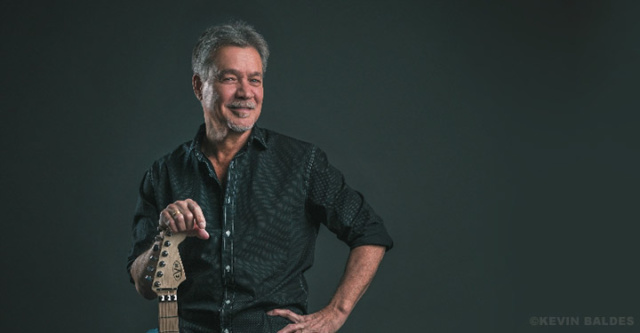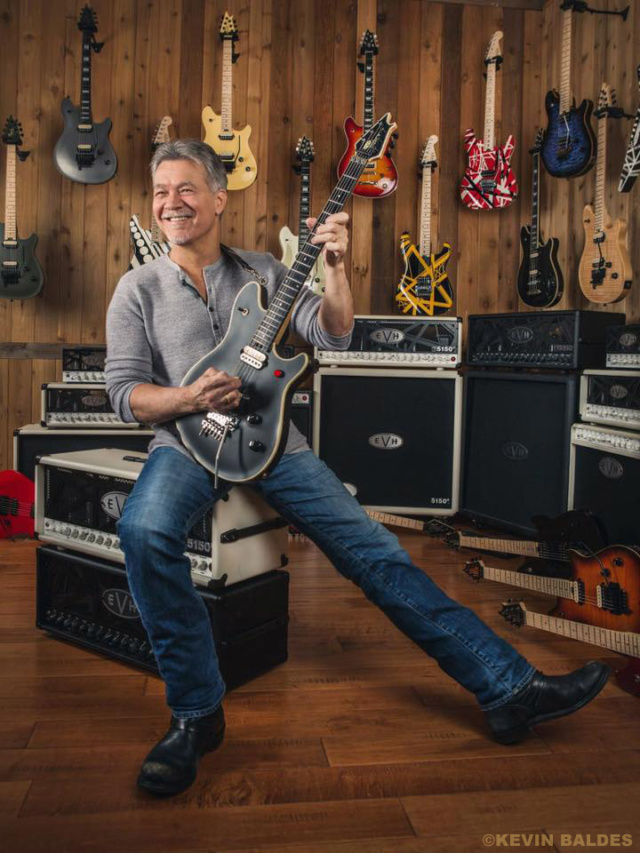
Chris Gill, who interviewed Eddie Van Halen 15 times between 1995 and 2016, offers a heartfelt tribute to one of the greatest guitarists the world has ever known.
[Originally written in 2020 for Guitar World]
EDWARD VAN HALEN IS GONE.
The greatest guitarist of our generation left this earth on October 6, 2020, after succumbing to a long, painful battle with cancer that had kept him away from the public spotlight for the last few years. He was only 65 years old.
News of Van Halen’s death shocked the guitar community, which is still mourning the loss of a man that many of us considered the most influential guitarist of our lifetime. It is certainly understandable to mourn Ed’s death, particularly since he passed earlier than most of us imagined he would, and his imagination and individual musical voice have now been silenced.
But while some are grieving his passing as the end of an era, the encouraging truth is that Ed’s numerous contributions to the guitar will live on for many more decades, and perhaps even centuries, well into the future. His life will endure as guitarists celebrate the many gifts Ed shared with the world that made our favored instrument better, more popular and enduringly cool.
The majority of Guitar World readers today are probably too young to remember what things were like before Edward Van Halen came along, but for many older guitarists — myself included — the release of Van Halen’s debut album on February 8, 1978, was as historic to my generation as the Beatles’ performance on The Ed Sullivan Show almost exactly 14 years earlier on February 9, 1964, was to the previous generation. I consider myself very fortunate that I got to witness Van Halen’s rise to fame as the band first gained exposure beyond the Los Angeles club scene, having heard “You Really Got Me” on Los Angeles radio station KMET when Warner Bros. rush-released the single about a month before the debut album hit record store shelves. The song’s unique sound — the brash, powerful guitar, massive drums, distinctive vocal harmonies and David Lee Roth’s wild screams — simply blew me away, but even that didn’t prepare me for what came soon after.
At 8 p.m. the day of the album’s release, San Diego radio station KGB (I lived in northern San Diego County so my radio picked up signals from both cities) played Van Halen in its entirety. I was mesmerized from the very first seconds of “Runnin’ with the Devil” as the cacophony of blasting car horns descended in pitch like a landing alien spacecraft, followed by a bass line that stomped like Godzilla crushing Tokyo, a dissonant metallic swipe of the strings between the guitar’s stop tailpiece and bridge (a sound I already recognized from my own wanderings beyond the fretboard) and the biggest rush of power chord fury I had ever heard.
Then came 102 seconds that changed my life forever — “Eruption.” I considered myself a connoisseur of the finest guitar music of the day, with a record collection that featured the work of guitarists like Al Di Meola, John McLaughlin and even Andres Segovia in addition to revered rock gods like Jimi Hendrix, the British “holy trinity” of Jeff Beck, Eric Clapton and Jimmy Page, Ritchie Blackmore, Brian May, Uli Jon Roth, Michael Schenker and many, many others, but “Eruption” sounded completely unlike anything I had ever heard before. The blazing tremolo-picked lines were immaculately precise; the vibrato bar dives plunged to the deepest lows; and the semi-classical flurry of triads that I soon discovered were generated by playing with both hands on the neck made the guitar sound like an entirely new instrument. But “Eruption” was impressive for much more than Ed’s rapid-fire licks and fretboard fireworks — every single note had a playful yet aggressive attitude, raw power and massive tone that still impresses to this day.
Many other jaw-dropping moments followed, including the hot-rodded blues boogie of “I’m the One” featuring two dazzling solos, the phase-shifted muted-string helicopter chop dissonance of “Atomic Punk” and the exploding harmonic fireworks and bombastic whammy bar dives of “On Fire.” Ed’s solos were filled with flash, dynamics and drama, and his tone was visceral and more violent than anything punk rock and heavy metal had delivered at the time. As soon as the record finished, I called my best guitar-playing buddy Robert, who had also heard the broadcast and was as awe-struck as I was. The next morning, we both rushed out to the record store to buy a copy of the album and set out on a race to see who could figure out how to play “Eruption” first.
That album had a profound effect on me, and I soon discovered that thousands of guitarists felt the same way, igniting a deep passion for the instrument that remains to this day for all of us. Some of us were there right at the beginning, while others discovered it a few months or even years later, but the overall effect was identical. It is the event that inspired us to look at the guitar in an entirely new way and to pursue careers that involved music. Some of my fellow guitarist friends and acquaintances that I met over the next few years who were similarly affected by Van Halen went on to become great guitarists themselves, some designed guitars, amps or pedals, a few became recording engineers and one illustrated album covers. I ended up working for record companies and musical instrument manufacturers before finding my dream job as a guitar journalist.
It took a few years before guitarists, instrument manufacturers and the record industry started to catch up with what Ed was doing as it took that long to get even a hint at what he was doing — many early reviews even mistakenly described “Eruption” as a synthesizer solo. Soon Van Halen’s influence became the pre-eminent driving factor for guitar music and gear throughout the entire Eighties into the early Nineties. It has often been said that Ed changed both the way the guitar was played and how it was made, but his influence is more far-reaching than the oft-cited examples of his signature tapping technique or the popularity of his “Super Strat” guitar design.
One of Van Halen’s most overlooked contributions is his impact on guitar education. The licks that Ed played went well beyond the common blues-based pentatonic scale patterns that many players could easily figure out by ear, which motivated many dedicated aspiring guitarists to seriously study the instrument like never before. During the late Seventies and Eighties, enrollment in guitar programs at Boston’s Berklee College of Music, Hollywood’s Guitar Institute of Technology, and other higher-learning establishments skyrocketed. Detailed note-for-note transcriptions and tablature became the new norm, replacing sheet music that only provided basic chord charts and simplified melodies adapted for piano players. Guitar magazines proliferated, with the previously established Guitar Player joined by Guitar World in 1980 and Guitar for the Practicing Musician in 1982, culminating with more than a dozen regular guitar publications available on newsstands in the mid-nineties in the United States and numerous others abroad in the U.K., Europe, and Japan.
The seeds of Ed’s inspiration truly began to sprout during the early Eighties. Hoping to discover the next Van Halen, Mike Varney established Shrapnel Records, which introduced the world to numerous virtuoso guitarists, including Michael Angelo Batio, Jason Becker, Marty Friedman, Paul Gilbert, Greg Howe, Richie Kotzen, Shawn Lane, Tony MacAlpine, Yngwie Malmsteen, and Vinnie Moore. After parting ways with Black Sabbath, Ozzy Osbourne, who certainly had fresh memories of Van Halen blowing his band off the stage every night when they toured together in 1978, joined forces with guitar phenom Randy Rhoads, who came from the same Hollywood club scene as Van Halen. It soon became common for vocalists to pair up with hotshot guitarists, like Billy Idol did with Steve Stevens, Ozzy continued to do with a string of players like Brad Gillis, Jake E. Lee, Zakk Wylde, and Gus G,. and even David Lee Roth did in the mid-eighties with Steve Vai when he left Van Halen to pursue a solo career.
There is not enough space to list all of the guitarists that Van Halen inspired who emerged in the Eighties and beyond. Most of these players used a “Super Strat” guitar with a Strat-style body, humbucking bridge pickup, and double-locking vibrato inspired by Van Halen’s original “Frankenstein,” making Ed’s design the most popular guitar style to emerge since the Gibson Les Paul and Fender Telecaster and Stratocaster were introduced in the Fifties — a distinction that endures today. B.C. Rich, Carvin, Charvel, Dean, ESP, Fernandes, Hamer, Ibanez, Jackson, Kramer, Robin, Schecter, Valley Arts, Washburn and Yamaha were among the larger companies that offered guitars with this design during the Eighties, and boutique shops from Pensa-Suhr in New York City to Performance Guitar in Hollywood established their initial success by building custom Super Strats as well.
Ed’s impact on the musical instrument industry reached much further than imitations of his signature guitar design. Pickup companies like DiMarzio and Seymour Duncan were just starting out when Van Halen came along, and Ed gave their business a huge boost when he discussed how he swapped his guitars’ pickups in interviews. His numerous experiments with amplifiers bolstered the popularity and development of high-gain amps as well as the emergence of amp techs that performed hot-rodded modifications, many of whom went on to establish boutique amp companies. Even replacement-tube companies benefited from Van Halen’s statements about preferring 6CA7 tubes in his Marshalls over stock EL34s, as guitarists who never previously gave tubes much thought unless they needed to be replaced suddenly became obsessed with finding the ideal tubes for their amps. Although Ed didn’t use distortion pedals, companies that manufactured them also benefited as guitarists sought an affordable means of boosting gain to replicate his tones.
While Ed is best known for his homemade “Frankenstein” guitars as well as the signature models he developed, first with Ernie Ball Music Man in 1990, then with Peavey in 1996 and the Wolfgang model introduced by his own EVH brand in 2009, he consistently explored new sounds from a wide variety of instruments throughout his career. Ed was one of the few guitarists who played a Ripley stereo guitar (on “Top Jimmy,” “Ripley” and “Blood and Fire”), and he was also one of only a handful of guitarists who truly mastered the revolutionary Stein- berger TransTrem vibrato, using it on “Get Up,” “Summer Nights,” “Pleasure Dome,” “Fire in the Hole” and “Me Wise Magic.” He even recognized the musical potential of amplifying a Makita cordless drill through his guitar’s pickups on “Poundcake.”
End of part 1. Tune in tomorrow for part 2.
Author Chris Gill:
Chris is the co-author of Eruption – Conversations with Eddie Van Halen., the best-selling book on Edward. He is a 40-year music industry veteran who started at Boardwalk Entertainment (Joan Jett, Night Ranger) and Roland US before becoming a guitar journalist in 1991. He has interviewed more than 600 artists, written more than 1,400 product reviews and contributed to Jeff Beck’s Beck 01: Hot Rods and Rock & Roll and Eric Clapton’s Six String Stories.
